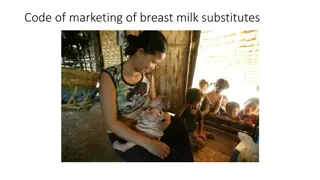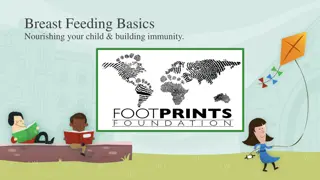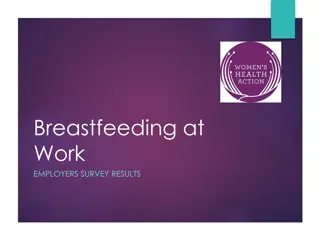Insights on Breastfeeding Throughout History and Modern Practices
Explore the evolution of breastfeeding practices from historical perceptions to modern approaches, emphasizing the importance of education and support for successful breastfeeding. Insights from key figures and contemporary principles like Biological Nurturing and Laid-back Breastfeeding are highlighted.
Download Presentation

Please find below an Image/Link to download the presentation.
The content on the website is provided AS IS for your information and personal use only. It may not be sold, licensed, or shared on other websites without obtaining consent from the author. Download presentation by click this link. If you encounter any issues during the download, it is possible that the publisher has removed the file from their server.
E N D
Presentation Transcript
Latch, Lets Get Comfortable SHEILA BRITT-SMITH M.ED, RD, IBCLC
Breastfeeding Through History Dr. William Cadogan An Essay Upon Nursing, 1748: It is with great pleasure I see at last the preservation of children become the care of men of sense. In my opinion, this business has been too long fatally left to the management of women, who cannot be supposed to have proper knowledge to fit them for such a task, notwithstanding they look upon it to be their own province.
Sir Frederick Truby King 1924 report: Just as the whole subject of Mothercraft does not come by instinct to a woman the moment she becomes a mother, but has to be studied, so does breast- feeding require thoughtful study and competent management if it is to be a success.
There can be no doubt in the minds of those taking care of modern Western European and American women that instinct does not inform the mother how to feed her first baby which is all the more remarkable since labor which is part of the same job is more effectively compulsive. Mavis Gunther, English obstetrician
Biological Nurturing A collective term for mother baby states and positions that interrelate and interact to release primitive neonatal reflexes and spontaneous maternal breastfeeding behaviors.
Biological Nurturing Instinctual breastfeeding A proactive, mother centered approach Comfort is priority
Laid-back Breastfeeding In 2008 Suzanne Colson PhD, Msc, Midwife, Nurse introduced the term
Positions Mother s Posture 1. Baby s Posture 2.
Mechanism of Biological Nurturing Mothers: Laid-Back Sitting postures Open the mother s body Increase her torso dimensions Make the body region between sternum and pubis available to her baby Optimize comfortable baby gazing and eye-to-eye contact
Mechanism of Biological Nurturing Gravity Pins baby to mother s body Reduces intensity & amplitude of PNRs Frees mother s hands to groom & stroke her baby
Mechanism of Biological Nurturing Babies: Ventral Positions Species-specific to quadrupeds No back, head, or neck pressure required Multidirectional approach to mum s breast Babies lie around the breast like the hands of a clock, increasing the number of positions Promote continuity in positional lie and attitude from womb to world Normalize longitudinal and oblique lies Close constant ventral contact smooths movement & releases PNRs enabling locomotion Work with (not against) gravity
Mechanism of Biological Nurturing Baby Gazing and Eye-To-Eye Contact Promote postnatal continuity of oxytocin from pregnancy & labor Increase maternal oxytocin pulsatility
Mechanism of Biological Nurturing High Oxytocin Pulsatility Releases mothers breastfeeding instincts Promotes spontaneous mothering behaviors protecting baby s breathing, warmth, and sleep
Mechanism of Biological Nurturing Biological Nurturing is proactive. Mothers take the lead; they hold their sleeping babies during the early days Keeps baby at the right address Reduces crying Mothers get to know their babies sooner, boosting confidence Reduces intensity and amplitude of PNR expression Promotes spontaneous latch in REM & drowsy sleep states Increases breastfeeding frequency mimicking womb feeding aiding metabolic adaptation Gives mothers time to sort latching difficulties or sore nipples REM states optimize brain development & early learning, therefore babies coordinate sucking with swallowing & breathing earlier.
A Good Fit Traditional Latch
A Good Fit Latching that takes into consideration fetal attitude in utero
The 3 Cs The 3 C s of Childbirth in the 1990 s: 1. Choice 2. Continuity 3. Control Today, postnatal care remains the Cinderella of midwifery care. In view of statistics of breastfeeding continuance, biological nurturing research suggests that it s time to apply the 3 C s to postnatal care as well
Bibliography Colson, Suzanne. An Introduction to Biological Nurturing: New Angles on Breastfeeding. Amarillo, TX: Hale Publishing, 2010. Print Colson, Suzanne. Biological Nurturing: Instinctual Breastfeeding, 2nd Revised and Updated. Amarillo, TX: Praeclarus Press, 2019. Print. Colson, Suzanne. Biological Nurturing (BN): More Than Mother s Laid- Back Breastfeeding Position. Praeclarus Press. 20 February, 2019. Webinar.

 undefined
undefined






























